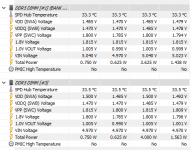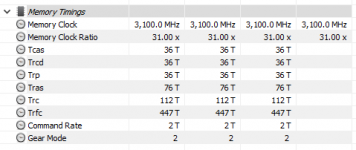GeIL has shared a press release detailing its new EVO V DDR5 RGB Hardcore Gaming Memory, the world's first DDR5 memory to feature active cooling in the form of dual RGB fans to help tame high temperatures.
Go to post
Go to post
Probably. We've seen active cooling and even waterblocks on memory kits early on with a new memory generation. Primarily because of the voltages that are required to run higher end modules at their rated XMP speeds using early IC's. Then all that crap fades into obscurity as everything moves to passive heat sinks and yields, IC's, etc. all imrpove.Imagine that actively cooled memory sticks that will be a thing for 6 months then completely forgotten about.
Exactly my point.Probably. We've seen active cooling and even waterblocks on memory kits early on with a new memory generation. Primarily because of the voltages that are required to run higher end modules at their rated XMP speeds using early IC's. Then all that crap fades into obscurity as everything moves to passive heat sinks and yields, IC's, etc. all imrpove.
It's the same old story every generation. You can pretty much apply the list below to virtually every generation from RDRAM and DDR onward.
Not everything in the above pattern applies to the earliest generations, but from roughly DDR2 onward, it does.
- Early on you get a lot of JEDEC spec memory with no heatsinks on it.
- First generation modules rarely attain performance that beats the legacy standards cheap, yet upper end modules.
- First generation modules that are actually faster than the outgoing standard are always extremely hard to come by and prohibitively expensive when you do find them.
- First generation modules that do have good performance often rely on gimmicky cooling that probably isn't needed in a lot of cases so long as there is adequate airflow. This is due in part to the higher voltages generally required to clock the new RAM high enough to actually outperform the old stuff.
- First generation XMP is a crap shoot. Compatibility is usually a massive headache on all the first generation chipsets that support the new platform. This problem is exacerbated by the fact that modules come out at a breakneck pace with latencies dropping, clocks increasing and a lot of revisions to the IC's themselves.
I have both a DDR3 and a DDR4 set like that too. Again, both are early generation kits.I've got the early generation Corsair Dominator DD2 with heatsinks and clip on fan frame that reinforces the "active cooling every generation" cycle.
Me too!I would like a hat that is actively cooled, my brain thermal throttles way too much.
For a single chip, ~5W seems to be right at about the limit where you need active cooling.There's really no reason for them to get as hot as they do otherwise, even using a bit more power we're still talking <10W per DIMM, right?


